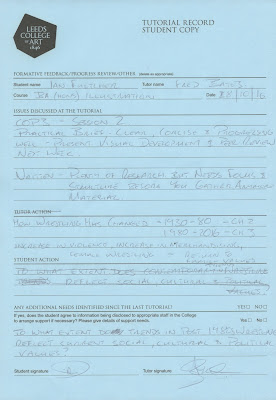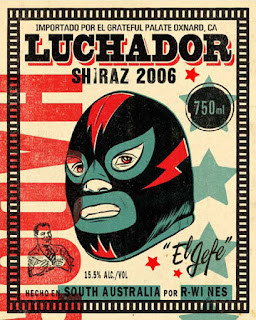(taken from 'The Guide to United States Popular Culture' By Ray Broadus Browne, Pat Browne)
----------------------------------------------------------------------------
Professional Wrestling
Has Been Ruined By Ego and Bureaucracy
By James Nolan (2015)
In the 1970s and 80s, professional wrestlers lived in a world of blood, brutality, and bad paydays. They adhered to a territory system that divided the country into 20 distinct parts, each of which they would tour until their act got stale. They traveled by car, splitting beer, gas, and pills, before arriving at shit-box motels to pass out in beds too small for their 300-pound frames.
Nowadays, pro-wrestlers are paid eight-figure sums, tour the country in plush tour buses and break character to console teary young fans at ringside. Back in the days of The Sheik and Tex McKenzie, tears were encouraged. It was a Wild West of greedy promotors and bitter veterans. The holds were hard and the blows were stiff, and with exposés yet to reveal the reality of the ring, the business was strictly "kayfabed" (protected) in fear that no one would pay to see a fake fight. Bill Watts, a promotor from Louisiana, told his wrestlers that if they ever got into a bar fight and didn't win, they were fired.
WWF was owned by Vince McMahon, a man whose tastes were softer-edged than the territories. He called his product "sports entertainment," not pro wrestling, and admitted quite openly that it was staged. Regardless, on Hulk Hogan's giant back, he propelled WWF to unheard-of heights.
Hogan, a flag-waving tank who told kids (his "Hulkamaniacs") to take their vitamins and say their prayers, was a long way off the territories' blood and guts. Wrestling remained serious there, but in WWE it became embarrassing and cartoonish, with personas including garbage men, dentists, hockey players, prisoners, and clowns.
--------------------------------
With WWE Network subscriber numbers in the US well below anticipated, and with pay-per-view buy-rates inevitably down, all WWE has achieved—along with losing McMahon a third of his fortune—is allowing their hardcore fan-base, who were happy to buy high-priced pay-per-views in the first place, access to them at a lower price.
This is indicative of WWE since they bought WCW, of not just the slide back toward the infantilism of the 90s, but of the mismanagement and bureaucracy now rife in its own ranks. Though McMahon still runs things, he's joined at the helm by his son-in-law, Triple H, a wrestler with the reputation of not letting others beat him.
The product has become stale—it lacks diversity and is again disconnected from the world around it, with wrestlers being taught to look the same, work the same, and act the same in their training camps (a far cry from the territories), and then by a team of writers.
-------------------------------
When my parents told me that wrestling was fake, it phased me for a second, but ultimately the dynamic of good vs. bad pulled me back in. This dynamic is everywhere: the Bible, Shakespeare, Greek myths... We identify with it so strongly because it simplifies life into the perfect equation of good equals us and bad equals our pain—and when good inevitably wins, we feel like we've beaten our pain, even if only fleetingly.
As fans get older and become more knowledgeable, this dynamic remains: there's always some wrestler who we feel is deserving of more—the hardest worker, the nicest guy—who we identify with in the hope that, one day, he'll get what he deserves.
Wrestling allows us to hope, to escape. And if it does die, we can replace it. But I still can't help being sad at the prospect of something that captured so many minds staying down for the 1, 2, 3.
----------------------------------------------------
Top 15 Ways WWE Has Changed In The Last Decade
(Matthew Byrd 2016)
WWE’s promo team may never shy away from reminding fans that the company has no offseason (they’re also particularly fond of reminding you that WWE is, in fact, not ballet), but you really do have to respect that the world’s largest wrestling company is indeed a 24/7, 365 brand of entertainment. Hardly a day goes by where they are not putting on one kind of show or another.
Among the many, many demands that come with putting out that much entertainment, the biggest among them may just be the need to stay fresh in an ever-changing world. If you think it’s tough for a wrestler to go out there nearly every day of the year and have a match, just imagine what a burden it is for the WWE creative team to somehow come up with new material when it’s all seemingly been done before.
But when you’re talking about comparing where WWE is now to where it was 10 years ago, you might as well be talking about different shows. WWE has changed so much in the last decade that it’s almost not even fair to compare the two eras. Then again, since it is fun to look at how different things really are, here are the 15 biggest differences between then and now.
full article>>
15. WOMEN’S WRESTLING INVOLVES A LOT MORE CLOTHING
While WWE didn’t sexualize their women’s wrestling matches 10 years ago quite as much as they did during the Attitude Era (let’s not forget that we were treated to quite a few “full flashes” back then), you could still expect the majority of women’s matches to feature someone losing their clothes. That’s not the case anymore. Not only has WWE moved away from mostly hiring women with “Wet T-Shirt Contest Champion” on their resumes, they’ve actually started to let their female performers wrestle long matches. No doubt some miss their weekly lingerie match fix, but this one is probably a change for the best.
9. THERE ARE MORE PART TIME STARS
It was never unusual for WWE to bring in a big name for a one-off appearance or short comeback tour, but you never really saw those part time guys actually play a major role in the championship picture. That certainly is not the case anymore as guys like Brock Lesnar and The Rock have had championship runs despite not being full-time members of WWE, and stars like The Undertaker continue to be main draws despite only working a few times a year at most.
7. THERE ARE LESS RIDICULOUS SEGMENTS
Modern WWE television may not be perfect – it never is – but if there is one thing you can take comfort in, it’s that there is a far less chance of tuning into an episode of Raw one week and seeing a storyline involving one wrestler sleeping with the elderly in order to convince another to have a one night stand. WWE was still trying to ween themselves of the Attitude Era 10 years ago, and the result of their efforts was a host of awkward storylines modified for a more PG era. You still see this occasionally, but thankfully not near as much.
6. GIMMICKS ARE MORE DOWN TO EARTH
Similar to how WWE used to have a lot more love for completely absurd storylines, they also used to be a lot fonder of assigning performers with the most outlandish gimmick they could possibly come up with. Whether it was Chavo Guerrero parading around as a stereotypical white man by the name of Kerwin White or the uncomfortably homophobic tag-team of Billy and Chuck, WWE used to be a wasteland of truly awful character ideas. Again this isn’t completely gone, but gimmicks are far more toned down these days, and mostly allow wrestlers to just be a version of themselves.
5. BLOOD IS ALMOST COMPLETELY GONE
The PG era of WWE has been in effect for some time, but 10 years ago WWE was willing to do things with a more PG product that you are less likely to see now. Along with the use of the aforementioned bra and panties matches, the most notable new taboo in WWE is blood. Maybe a couple of times a year you will see someone bleed during a match – usually Brock Lesnar – but blood is not nearly as prevalent as it once was when you could expect to see a little bleeding on a monthly basis, at least.
4. WWE PUSHES DIFFERENT KINDS OF WRESTLERS
As a rule, if you didn’t look like you could win a bodybuilding competition there was very little chance of you becoming a WWE champion 10 years ago. It was an era where you could accurately order the card standings simply by arranging the performer’s max bench press. While WWE will likely always have a fondness for the biggest kid on the block, it’s hard to deny that this current era allows for a greater variety of stars than ever before. Guys like Seth Rollins and Daniel Bryan would have never gotten a title shot 10 years ago, and are now some of the most beloved champions in recent memory.
------------------------------------------------------------------
(Why WWE & Wrestling Isn’t What It Used To Be)
WWE is no longer a professional wrestling company with a professional wrestling ring. It is an entertainment brand using a wrestling ring as a stage. But so much more than wrestling happens there. Comedy skits, monologues, arguments, even dance contests can occur at any moment.







































